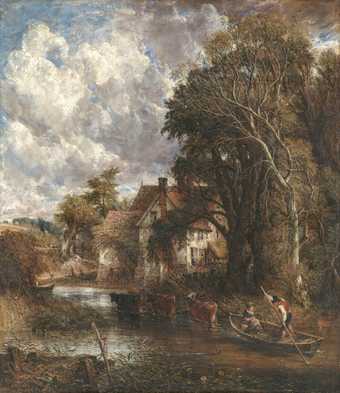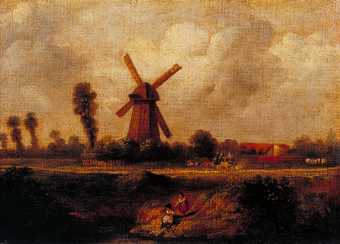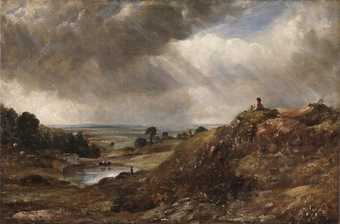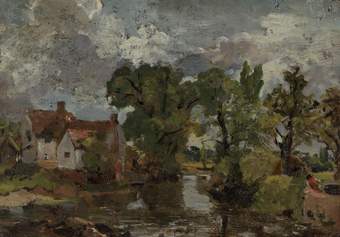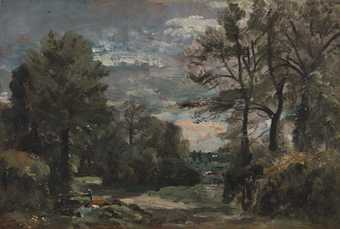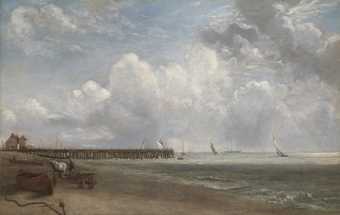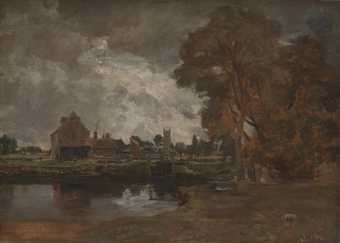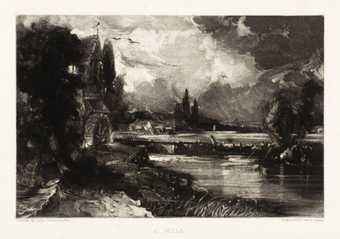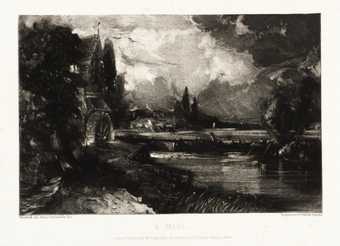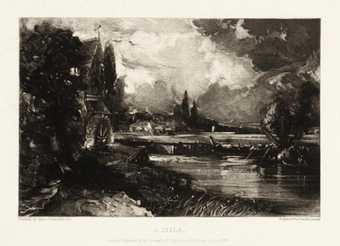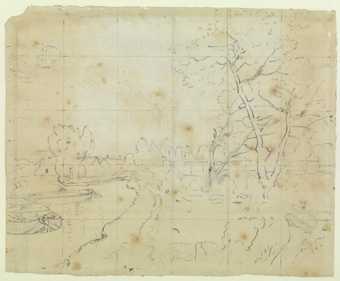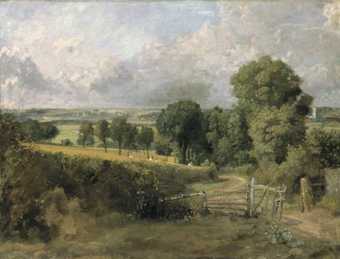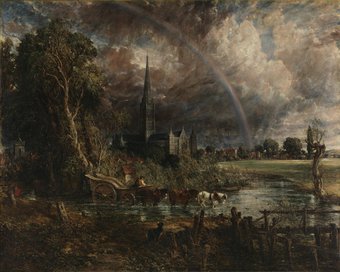
In Tate Britain
- Artist
- John Constable 1776–1837
- Medium
- Oil paint on canvas
- Dimensions
- Support: 1016 × 1270 mm
frame: 1331 × 1583 × 162 mm - Collection
- Tate
- Acquisition
- Bequeathed by Miss Isabel Constable as the gift of Maria Louisa, Isabel and Lionel Bicknell Constable 1888
- Reference
- N01273
Summary
Constable began this picture, his largest exhibition canvas to be painted mainly outdoors, a few months before his marriage to Maria Bicknell (see Tate Gallery T03900). He wrote to Maria from Bergholt on 12 September 1816: 'I am now in the midst of a large picture here which I had contemplated for the next exhibition - it would have made my mind easy had it been forwarder - I cannot help it - we must not expect to have all our wishes complete' (in R.B. Beckett, ed., John Constable's Correspondence, II, Ipswich 1964, p.203). Prior to 1814, the artist produced his exhibition pictures in the studio, working from oil sketches and drawings, but in that year he declared his intention to make finished paintings from nature. The summers of 1816 and 1817 were the last occasions upon which Constable spent any length of time at East Bergholt, and the last in which the artist painted directly from the scenery of his Suffolk childhood.
Constable frequently depicted the scenes of his 'careless boyhood' which, he wrote to his friend Archdeacon Fisher, he associated with 'all that lies on the banks of the Stour. They made me a painter (& I am gratefull)' (letter of 23 October 1821; in Beckett, VI, 1968, p.78). The Constable family business was at Flatford, about a mile from East Bergholt. The family had a watermill on the Stour for grinding corn, and a dry dock for building the barges to transport grain to Mistley for shipment to London, as well as a watermill upstream at Dedham. The passage up and down the river required the use of horse-drawn barges; the ropes had to be disconnected in order to allow the barges to be poled under Flatford bridge. In this picture, a boy is disconnecting a rope and another sits astride a tow-horse. Constable painted the inscription to appear as if it had been scratched in the earth with a stick.
Although the painting was probably executed largely on the spot, various details were almost certainly added in the studio, such as the boy and the horse, the timberwork in the foreground and the mooring-post on the left. It is known from x-rays that the artist painted out a horse on the tow-path and substituted the figures of two boys. Constable evidently experienced difficulty painting outdoors on such a large canvas as this one, for after showing it at the Royal Academy in 1817, he repainted the tops of the trees and the entire sky, presumably in time for the picture's second showing at the British Institution in January 1818.
Constable made several drawings and oil sketches of the subject from various angles, but the only certain preparatory studies for the picture are an oil sketch in the collection of David Thomson and two drawings, one in the Tate (Tate Gallery T05493). This is a pencil tracing of an image made with a brush on a sheet of glass held on an easel in front of the subject itself. The tracing was made by placing a piece of paper over the image on the glass, and was squared for transfer to the canvas. It contains the two barges but none of the figures seen in the painting.
Further reading:
Leslie Parris and Ian Fleming-Williams, Constable, exhibition catalogue, Tate Gallery, London 1991, pp.17, 69, 120, 179-81, 229, 286,
413, 467, 469, 510, reproduced p.181 in colour
Terry Riggs
February 1998
Does this text contain inaccurate information or language that you feel we should improve or change? We would like to hear from you.
Display caption
Landscape painting flourished in the 19th century, ranging from the epic, through rustic nostalgia to the naturalism championed by John Constable. He based what he called his ‘natural painture’ on study of nature, experience of his subjects and attention to working life, especially in the Stour Valley where his father was a miller and merchant. When possible, he sketched or worked on pictures outdoors. Flatford Mill shows barges approaching Flatford footbridge after passing through the lock near his father’s mill. Its bright, airy realism was unprecedented at the time.
Gallery label, February 2016
Does this text contain inaccurate information or language that you feel we should improve or change? We would like to hear from you.
Catalogue entry
N01273 Scene on a Navigable River (Flatford Mill) 1816–17, dated & exhibited 1817
Oil on canvas, 40×50 (101.7×127). Inscribed by the artist ‘Joll Constable. f:1817.’ bottom centre, in simulation of writing incised in the earth.
Prov: Executors of John Constable, sold Foster and Sons 16 May 1838 (54, ‘Flatford Mills, Horse and Barge’), bt. in by C.R. Leslie at £52.10s. for the Constable family; bequeathed by Isabel Constable to the National Gallery 1888, as the gift of Maria Louisa, Isabel and Lionel Bicknell Constable; transferred to the Tate Gallery 1957. Accession N01273.
Exh: R.A. 1817 (255, ‘Scene on a navigable river’); B.I. 1818 (91, ‘Scene on the Banks of a River’, size of frame 58×68 inches); R.A., Old Masters, 1871(242); Leeds 1913(68); Tate Gallery 1937(p.18, No.31); Two Hundred Years of British Painting, Public Library and Art Gallery, Huddersfield, 1946(92); Hamburg, Oslo, Stockholm and Copenhagen 1949–50(14); Venice 1950(10); Manchester 1956(18); Moscow and Leningrad 1960(57); Tate Gallery 1971(92); Tate Gallery 1976(151).
Engr: in mezzotint by David Lucas as ‘Flatford Mill’ and published by him 1845, although the publication line reads 1844 (Shirley 1930, No.46).
Lit: Holmes 1902, pp.83, 119, 243; Shirley 1937, pp.lxvii, 99,120; Davies 1946, pp.28–9; Kitson 1957, pp.344–5; Beckett 1961, Paintings: Suffolk B(40–41) No.86; Reynolds 1965, pp.56–60; Charles Rhyne, ‘Fresh Light on John Constable’, Apollo, LXXXVII, 1968, p.230; Taylor 1973, pp.28,41,43; Smart and Brooks 1976, pp.68–72, 134; Hoozee 1979, No.233.
‘Flatford Mill’, as it is generally called today, was the forerunner of the series of six-foot canvases of river subjects which Constable began exhibiting in 1819. He had already shown a river landscape of the same size as No.14 - ‘Landscape: Boys fishing’ in 18131 - but this did not depict the working life of the Stour. In ‘Flatford Mill’ and the larger canvases that followed (‘The White Horse’, ‘Stratford Mill’, ‘The Hay Wain’ and so on), barges and bargees, towing-horses and their riders, and the operation of locks became central features.
No.14 shows the view from the southern end of the footbridge at Flatford, looking along the tow-path to Flatford lock and the mill buildings beyond. The viewpoint, slightly above ground-level, is on the slope up to the bridge, the first timbers of which appear in the bottom left corner of the picture. On the river a pair or ‘gang’ of barges is about to be poled under the bridge. The figure crouching on the bank behind the towing-horse seems to be drawing in the disconnected tow-rope.
Like so many of Constable's pictures, the composition had its origin in the 1814 sketchbook (V.&A., r.132),2 page 61 of which (Fig.1), dated 14 August, corresponds fairly closely with the centre and right hand side of the painting. Page 63 in the same sketchbook (Fig.2) is not directly related but shows from a different angle the clump of trees seen at the fork of the river in the left middle-distance of No.14. Page 10 in the 1813 sketchbook (Fig.3, V.&A., r.121)3 gives a view of the whole scene but from the opposite bank, just upstream of the bridge. This variant composition appears again in an oil study now in the collection of Mr A.L.Gordon (Fig.4, h.170).4 Two further oil studies in private collections are more closely related to the painting. In one (Fig.5, tg 1976 No.130, h.231)5 the river and mill buildings are seen from the bridge rather than from the slope up to it, while the other (Fig.6, tg 1976 No.131, h.232),6though vertical in format, presents the subject from more or less the same viewpoint as in the painting. However, the study (if study it is) most directly connected with No.14 is one formerly in the collection of P.A.B.Widener (Fig.7, W.Roberts, Pictures in the Collection of P.A.B.Widener ... British & Modern French Schools, 1915, No.2, h.617).7 This lacks the barges and human figures but includes the foreground horse and shows another horse further along the tow-path, where the two boys appear in No.14. The authenticity of this work has been questioned but a point in its favour emerged when No.14 was x-rayed by the Courtauld Institute in 1975: Constable originally painted a horse in exactly the position indicated in the Widener picture, i.e. where the reclining boy now appears (Fig.8). Once looked for, the painted-out horse can still be seen. It seems likely that the standing boy with his long stick was originally shown feeding this horse and, perhaps because the incident distracted too much from the distant view, that Constable decided to move the animal to its present, less conspicuous position beside the lock, substituting for it a second, reclining, boy. The horse's collar and towing gear were, however, left behind on the grass beside the boy and his new companion. The two privately owned oil studies reproduced in Figs.5–6 and the Widener picture were presumably all made after 14 August 1814 since they omit a large branch which Constable noted on the foremost tree in his sketchbook drawing that day (Fig. 1).
On 12 September 1816, three weeks before their marriage, Constable wrote to Maria Bicknell from East Bergholt: ‘I am now in the midst of a large picture here which I had contemplated for the next exhibition - it would have made my mind easy had it been forwarder’ (JCC II, p.203). The picture was almost certainly ‘Flatford Mill’. Farington definitely saw it when he called on Constable on 2 January 1817 ‘to look at several painted studies from nature made by Him last Summer & autumn; also a large landscape composed of the Scenery abt Dedham in Essex. I exhorted Him to compleat them.-’ (Farington was frequently rather vague about the topography of Constable's pictures).8
Although much approved by some Academicians (including Beechey, who seems to have set going a rumour about Constable's imminent election to the Academy: JCC II, pp.219–20), the painting attracted little notice at the 1817 exhibition and failed to sell.9 When he got it back Constable appears to have repainted the foliage at the top of the large tree at the right and most of the smaller tree behind it. Pentimenti can be seen in these areas and the 1975 x-rays show the shape of the smaller tree to have been more regularly curved, as on p.61 of the 1814 sketchbook (Fig. 1). A large, detailed drawing of the two trees (Fig.9, V.&A., r.161, tg 1976 No.154),10 dated 17 October 1817, i.e. well after the R.A. exhibition, corresponds very exactly with the repainted areas, while differing in other parts, and was presumably made specifically for these revisions. Constable's further work on the picture made no difference to its immediate fate. It found no buyer when shown at the British Institution in 181811 and even twenty years later, in the artist's sale, failed to reach its reserve price.
1. Probably the picture in the Fairhaven Collection at Anglesey Abbey, which measures 40×49 1/2 inches (tg 1976 No.118, h.174).
2. Page size, 3 3/8×4 1/4 (8×10.8).
3. Pencil, 3 1/2×4 3/4 (8.9×12.1).
4. Oil on canvas, 9 13/16×7 1/2 (25×19).
5. Oil on paper, 4 1/2×6 1/8 (11.4×15.6).
6. Oil on canvas, 9 1/2×7 1/2 (24.1×19). Ian Fleming-Williams suggests that this sketch is the earliest known example of Constable painting with a palette knife.
7. Oil on canvas, 13 1/2×16 1/4 (34.3×41.3). Fig.7 is taken from the illustration in the 1915 catalogue: the picture is untraced today.
8. The possibility that Constable was already working on ‘Flatford Mill’ in 1815 was discussed in a footnote to the entry on the picture in the 1976 Constable exhibition catalogue. That note, however, overlooked Beckett's plausible identification (JCC IV, p.45) of the picture Constable began in 1815 with the work D.P. Watts bought the following year, i.e. ‘A wood: Autumn’, exhibited at the R.A. in 1816.
9. The Literary Gazette, 10 May 1817, p.249, mentioned the painting as ‘a river scene, in very improved style’. When the work reappeared at the British Institution the following year, the same journal commented: ‘There is quite a magical effect in this landscape, which reaches a degree of the deceptive in art which we rarely see displayed, without any of those sacrifices we find so often made to form, colour, or composition. It is in short a perfect panorama, but a panorama not indebted to the usual means called in to produce panoramic effect. The character of the pencilling is no less extraordinary; - and the making out of the foliage denotes great labour to attain the rude in nature, which is yet far removed from neglect’ (21 March 1818, p.186).
10. Pencil, 21 3/4×15 1/8 (55.2×38.5).
11. Annals of the Fine Arts, III, 1818, No.8, p.175 reported the sale of the picture to James Sedgwick but this was presumably a mistake since the painting appeared in the artist's sale in 1838. The same journal named Thomas Barber as the purchaser of Constable's other exhibit at the British Institution that year, ‘A Cottage in a Cornfield’, but Constable had almost certainly sold this work to William Venables: see Ian Fleming-Williams, ‘A rediscovered Constable: the Venables Cottage in a Cornfield’, The Connoisseur, Vol.198, 1978, p.135. Judy Ivy kindly drew the reference in Annals of the Fine Arts to my attention.
Published in:
Leslie Parris, The Tate Gallery Constable Collection, London 1981
Explore
- architecture(30,960)
-
- industrial(2,075)
- townscapes / man-made features(21,603)
- boy(1,153)
- Suffolk(389)
- East Anglia(913)
- England(19,202)
- England, East(1,353)
- River Stour(43)
- transport: land(2,189)
-
- riding(512)
- boat, barge(484)
- trading and commercial(1,154)
-
- boatman(60)
You might like
-
John Constable The Valley Farm
1835 -
Formerly attributed to John Constable ‘Barnes Common’
date not known -
John Constable The Grove, Hampstead
c.1821–2 -
John Constable Branch Hill Pond, Hampstead Heath, with a Boy Sitting on a Bank
c.1825 -
John Constable The Mill Stream. Verso: Night Scene with Bridge
c.1810 -
John Constable A Lane near Flatford
c.1810–11 -
John Constable Yarmouth Jetty
after 1823 -
John Constable Dedham Lock and Mill
?1817 -
Formerly attributed to John Constable The Leaping Horse
date not known -
John Constable, David Lucas A Mill
date not known -
John Constable, David Lucas A Mill
date not known -
John Constable, David Lucas A Mill
date not known -
John Constable Study for ‘Flatford Mill’
c.1816 -
John Constable Fen Lane, East Bergholt
?1817 -
John Constable Salisbury Cathedral from the Meadows
exhibited 1831

